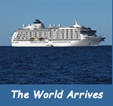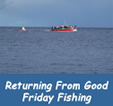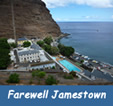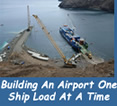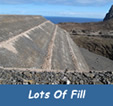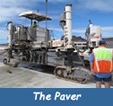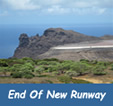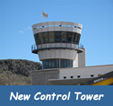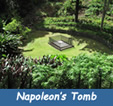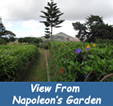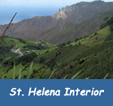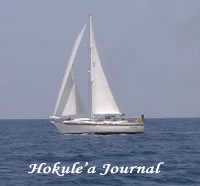
Around The World On Hokule'a
Saint Helena
Saturday, April 4, 2015 – Jamestown Bay, Saint Helena
For an incredibly remote island, St. Helena has certainly had a surprising number of big ships vi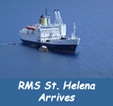 sit this week including the RMS Saint Helena, the BasilRead cargo ship, a cruise ship, a fuel tanker (delivers fuel about once a year), and a ship called The World. The World is basically a cruise ship with 165 private residences, where most of the owners live onboard while the ship travels around the globe. Just like Hokule’a only about 600 feet longer.
sit this week including the RMS Saint Helena, the BasilRead cargo ship, a cruise ship, a fuel tanker (delivers fuel about once a year), and a ship called The World. The World is basically a cruise ship with 165 private residences, where most of the owners live onboard while the ship travels around the globe. Just like Hokule’a only about 600 feet longer.
Yesterday was Good Friday and the Saints have a tradition where the men go fishing from Friday afternoon until Saturday morning. Most of them fish from shore and since the island is so rugged,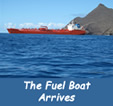 they have to be dropped off at their favorite fishing spots by the Harbor Master’s boat and picked up the next day. Being that it is Easter weekend and most everything on the island is closed, we have decided that it is probably a good time to start heading to our next destination, Ascension Island. Not to mention that the weather looks pretty good for the 700 mile trip.
they have to be dropped off at their favorite fishing spots by the Harbor Master’s boat and picked up the next day. Being that it is Easter weekend and most everything on the island is closed, we have decided that it is probably a good time to start heading to our next destination, Ascension Island. Not to mention that the weather looks pretty good for the 700 mile trip.
Saint Helena has been an amazing stop for us and we are really going to miss all of our new Saint friends. Especially Robert (our taxi driver) who just dropped off a bon voyage gift for “the American Yati’s” on Kite and Hokule’a. The pumpkin picked fresh from his garden is going to taste pretty good after a few days at sea….
Wednesday, April 1, 2015 – Jamestown Bay, Saint Helena
So in addition to all the other great things about this island, the diving here in St. Helena is amazing. Jack, Zdenka and I had the chance to dive at a beautiful spot called Lighters Reef on Monday and this morning I got to dive on the wreck of a huge fishing vessel. The water is warm, clear and teeming with life. There is nothing like coming out of a wreck and having a huge manta ray swim just a few feet over your head. Also, there was a whale shark swimming around the anchorage today, but didn’t get to see it underwater.
As I mentioned before, the only way to get to St. Helena today is by boat and the quickest way is via the RMS Saint Helena which takes about 5 days from Cape Town. But that is all about to change early next year as an airport is currently being constructed. Being an airport guy, I was really excited to see the project and after a bit of pestering I was finally able to arrange a tour with the contractor, BasilRead.
The terrain on St. Helena is very mountainous, so finding a site to build a 6000’ runway was a real challenge and required filling a nearly 300’deep canyon with over 21 million cubic yards of material. Even with this massive grading operation the runway still seems to precipitously end at the edge of a cliff. Another challenge is that nearly all of the materials, labor and equipment for construction of the airport have to be delivered by ship, so BasilRead’s first task was to build a breakwater to create a safe harbor where they could land and unload materials. Of course then they had to build a road from the harbor to the airport site.
The Saints have very mixed feelings about construction of the airport. Most see it as a benefit from the aspect of having access to better emergency medical services, but all are concerned about how it will affect their way of life. The British are funding the majority of the cost for the airport with the goal of increasing tourism and revenue generation for the Saints, but the rumor on the street is that the British really want to use it as an option for a military airport. Only time will tell how much of an impact the new airport will have and hopefully it will be a change for the better…
Sunday, March 29, 2015 – Jamestown Bay, Saint Helena
St. Helena is turning out to be an awesome place for hiking. They have a Nature Conservancy G roup that has published a hiking guide with maps and descriptions of 21 different hikes around the island. These hikes are called “Post Box Walks” because at the summit of each hike there is a post box that contains an ink stamp and a visitor’s log book. We have done a few of the walks over the past couple days including one to the highest point on the island called Diana’s Peak (2,290 feet) and one out to the stunning South West Point. Along the way to South West Point we were able to see one of the world’s most endangered species called the Wirebird, which is the last survivor of the islands 9 endemic birds. In 2006 there were only 210 Wirebirds left, but recent conservation efforts to protect their habitat have increased the population.
roup that has published a hiking guide with maps and descriptions of 21 different hikes around the island. These hikes are called “Post Box Walks” because at the summit of each hike there is a post box that contains an ink stamp and a visitor’s log book. We have done a few of the walks over the past couple days including one to the highest point on the island called Diana’s Peak (2,290 feet) and one out to the stunning South West Point. Along the way to South West Point we were able to see one of the world’s most endangered species called the Wirebird, which is the last survivor of the islands 9 endemic birds. In 2006 there were only 210 Wirebirds left, but recent conservation efforts to protect their habitat have increased the population.
~ 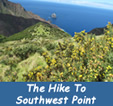 ~
~ 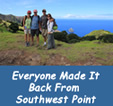 ~
~ 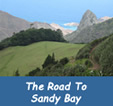 ~
~ 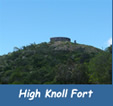 ~
~ 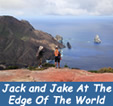 ~
~ 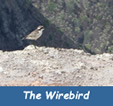 ~
~
Thursday, March 26, 2015 – Jamestown Bay, Saint Helena
We have spent the past two days touring inland Saint Helena with a local taxi driver named 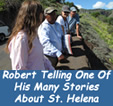 Robert Peters. Robert has a great sense of humor and million stories about the history of the island.
Robert Peters. Robert has a great sense of humor and million stories about the history of the island.
One of the many highlights was visiting the Longwood House where Napoleon was “imprisoned” and ultimately died. After Napoleon escaped from his first exile on Elba Island in Italy, the British recaptured him and sent him to “the most remote island on earth” – Saint Helena. Not a bad place to be exiled as the Longwood House sits on a hill with great views of the island and the ocean. It also has large garden area that apparently Napoleon took care of himself. He also received regular shipments of 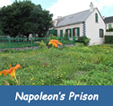 French wines and cheeses. But in 1821, Napoleon died at the Longwood House only 6 years after being sent to Saint Helena. We also visited the tomb where he was buried for roughly 20 years, until the French finally obtained permission to bring his remains back to France.
French wines and cheeses. But in 1821, Napoleon died at the Longwood House only 6 years after being sent to Saint Helena. We also visited the tomb where he was buried for roughly 20 years, until the French finally obtained permission to bring his remains back to France.
Robert also took us to the Plantation House which was built in 1792 and is where the Governors of St. Helena live. It is also home of the oldest Saint - a giant tortoise named Johnathan who is over 180 years old. We also visited a small coffee plantation and learned all about how coffee is grown and pro duced. We were very surprised to find out that St. Helena coffee is currently the 3rd most expensive coffee in the world.
duced. We were very surprised to find out that St. Helena coffee is currently the 3rd most expensive coffee in the world.
We visited the oldest Anglican church in the southern hemisphere, a distillery, a cemetery where dozens of Boer prisoners were buried, ….. and it would probably take about 10 more pages to tell you about all the places and stories that Robert has shared with us. It’s been fascinating and the interior of this island is incredibly green and beautiful. So after spending 2 days riding around in Robert’s truck, tomorrow we are going to explore a bit on foot by hiking up to the highest point on the island. Might have to splurge and have a cup of St. Helena coffee first….
Tuesday, March 24, 2015 – Jamestown Bay, Saint Helena
Yesterday we were so excited to be on land, we decided to get a little exercise and go up what is known as “Jacobs Ladder”. The ladder is the remnants of a tramway built in 1829 that was used to take manure and military supplies up and out of Jamestown so that they could be transported to other parts of the island. Let’s just say that climbing up 699 stair steps and back down 699 stair steps probably wasn’t the smartest thing to do on our first full day on land after 12 days at sea. Our legs are certainly a little sore this morning.
as “Jacobs Ladder”. The ladder is the remnants of a tramway built in 1829 that was used to take manure and military supplies up and out of Jamestown so that they could be transported to other parts of the island. Let’s just say that climbing up 699 stair steps and back down 699 stair steps probably wasn’t the smartest thing to do on our first full day on land after 12 days at sea. Our legs are certainly a little sore this morning.
So we are taking it easy today, with our only planned activity being to top up our diesel fuel since we had to motor a bit on the trip here from Cape Town. Normally having to get diesel fuel would not be considered taking it easy, as we usually have to transport fuel to the boat via jerry cans. With our 3 jerry cans we can only transport 15 gallons at time. Having to load the cans in the dingy, motor toshor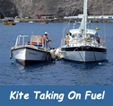 e, unload the cans from the dingy, walk or ride to a place to get fuel, fill the cans, walk or ride back to the dingy, load the cans into the dingy, motor back out to the boat, unload the cans onto the boat, and finally pour the fuel from the cans in to the boat’s tanks is a pain in the butt. But having to make 5 or 6 of those trips in order to fill up your fuel tanks can be downright exhausting. Fortunately in Saint Helena they have a fuel boat that brings diesel out to you. How cool is that? It even comes equipped with a bunch of big fenders so that you don’t have to worry about damage to either boat when the swell is up. The guys on the fuel boat were super friendly too. Come to think of it, all of the Saints (residents of Saint
e, unload the cans from the dingy, walk or ride to a place to get fuel, fill the cans, walk or ride back to the dingy, load the cans into the dingy, motor back out to the boat, unload the cans onto the boat, and finally pour the fuel from the cans in to the boat’s tanks is a pain in the butt. But having to make 5 or 6 of those trips in order to fill up your fuel tanks can be downright exhausting. Fortunately in Saint Helena they have a fuel boat that brings diesel out to you. How cool is that? It even comes equipped with a bunch of big fenders so that you don’t have to worry about damage to either boat when the swell is up. The guys on the fuel boat were super friendly too. Come to think of it, all of the Saints (residents of Saint 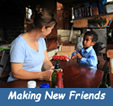 Helena) that we’ve met have been super friendly.
Helena) that we’ve met have been super friendly.
Since the fuel fill up was so easy, we have decided that our legs could probably handle heading into town … at least for a bite to eat.
~~~~~~~~~~ 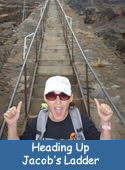 ~~~~~~~~~~
~~~~~~~~~~  ~~~~~~~~~
~~~~~~~~~ 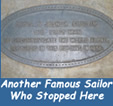 ~~~~~~~~~~
~~~~~~~~~~
Sunday, March 22, 2015 – Jamestown Bay, Saint Helena
We arrived at Saint Helena about 1:30am this morning. Nothing like approaching an unfamiliar isla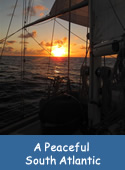 nd with heaps of unlit boats and buoys and trying to pick up a mooring when it is raining and pitch black out. Thankfully, our friends Jack and Zdenka on Kite had arrived just before sunset and radioed back some waypoints for us to follow. After tying up to the mooring, we enjoyed a celebratory glass of champagne in the cockpit and then found ourselves too tired to clean out our aft berth (used for storage of some items while underway). So we simply passed out in our sea berths in the main saloon. We awoke this morning to the sound of surf crashing on the striking cliffs of the island (which now look really close in the daylight).
nd with heaps of unlit boats and buoys and trying to pick up a mooring when it is raining and pitch black out. Thankfully, our friends Jack and Zdenka on Kite had arrived just before sunset and radioed back some waypoints for us to follow. After tying up to the mooring, we enjoyed a celebratory glass of champagne in the cockpit and then found ourselves too tired to clean out our aft berth (used for storage of some items while underway). So we simply passed out in our sea berths in the main saloon. We awoke this morning to the sound of surf crashing on the striking cliffs of the island (which now look really close in the daylight).
The trip here was a good one and the South Atlantic lived up to its reputation for mostly calm conditions, although maybe a bit too calm at times. The 1,700 nautical mile trip from Cape Town took 11 days and 17 hours consisting of 3 days of motoring with no wind, 4 days of light air sailing in 8-12 knots, 2 days of good sailing in 12-20 knots, and 2 days of 20-30 knots.
From the ocean Saint Helena appears to be a giant barren rock, but the interior is amazingly green and  lush with tropical vegetation. The island is a British territory and has a fascinating history as a mid-ocean port of call for sailing ships and as a good place to exile prisoners due to its extreme remoteness. The most famous person imprisoned here was Napoleon, who ultimately died on the island. In its heyday back in mid-1800’s, St. Helena would see a few hundred ships a year stop to re-provision with food and water. Even today the only way to get to Saint Helena is by boat, although an airport is currently being constructed.
lush with tropical vegetation. The island is a British territory and has a fascinating history as a mid-ocean port of call for sailing ships and as a good place to exile prisoners due to its extreme remoteness. The most famous person imprisoned here was Napoleon, who ultimately died on the island. In its heyday back in mid-1800’s, St. Helena would see a few hundred ships a year stop to re-provision with food and water. Even today the only way to get to Saint Helena is by boat, although an airport is currently being constructed.
The RMS (royal mail ship) St. Helena is the primary boat that transports passengers between St. Helena, Cape Town and the UK. It arrives in St. Helena about once month and can carry a maximum of 156 passenger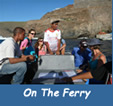 s. It also brings all types of food and supplies to the island including as the name implies…the mail. Getting those supplies and people ashore can be a challenge as there is no protection from the frequent huge swells generated from storms in the North Atlantic that crash on to the wharf here in Jamestown. Fortunately for cruisers there is a ferry service that you can call on the radio to take you from your boat to the wharf. The ferry landing consists of varying height concrete platforms with knotted ropes hanging down from an overhead metal support. When the swell is big, you have to wait until the ferry boat rises with the wave, then grab a rope and step over to the concrete platform before the boat drops on the backside of the wave. Then you have to move quickly to the stairs to avoid being knee deep in water from the next wave. This is even more exciting when you have a heavy back pack full of things that don’t like to get wet such as a computer, ipad, camera, passports, etc. and you are carrying something in each hand such as a bag of trash, groceries or jerry cans. We should be pretty good at it by the time we leave…
s. It also brings all types of food and supplies to the island including as the name implies…the mail. Getting those supplies and people ashore can be a challenge as there is no protection from the frequent huge swells generated from storms in the North Atlantic that crash on to the wharf here in Jamestown. Fortunately for cruisers there is a ferry service that you can call on the radio to take you from your boat to the wharf. The ferry landing consists of varying height concrete platforms with knotted ropes hanging down from an overhead metal support. When the swell is big, you have to wait until the ferry boat rises with the wave, then grab a rope and step over to the concrete platform before the boat drops on the backside of the wave. Then you have to move quickly to the stairs to avoid being knee deep in water from the next wave. This is even more exciting when you have a heavy back pack full of things that don’t like to get wet such as a computer, ipad, camera, passports, etc. and you are carrying something in each hand such as a bag of trash, groceries or jerry cans. We should be pretty good at it by the time we leave…
~~~~~~~~~~ 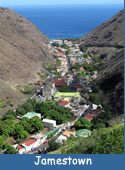 ~~~~~~~~~~
~~~~~~~~~~ 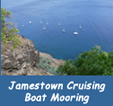 ~~~~~~~~~~
~~~~~~~~~~ 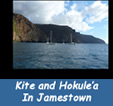 ~~~~~~~~~~
~~~~~~~~~~
